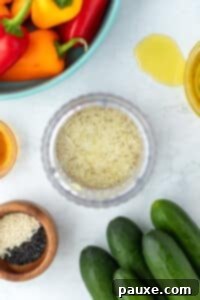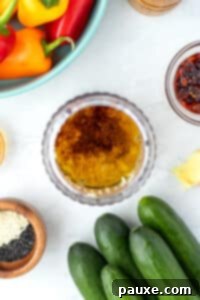Unlock an explosion of vibrant flavors with this incredibly simple, yet profoundly delicious, **Ginger Sesame Dressing** recipe. Crafted from basic pantry staples, this homemade vinaigrette comes together in under 10 minutes, promising a fresh and exciting addition to your culinary repertoire. Forget bland store-bought options; this dressing offers a dynamic zest that will transform your meals.
More than just a salad dressing, its versatility knows no bounds. Perfect for drizzling over crisp greens, enhancing hearty grain bowls, or tossing with noodles, it can even double as a fantastic marinade for your favorite proteins. If you appreciate the aromatic warmth of ginger, the nutty depth of sesame, and the pungent kick of fresh garlic, prepare to be captivated by this essential recipe. It’s a flavor powerhouse that far surpasses the one-note profile of many common dressings, inviting a delightful complexity to every bite.
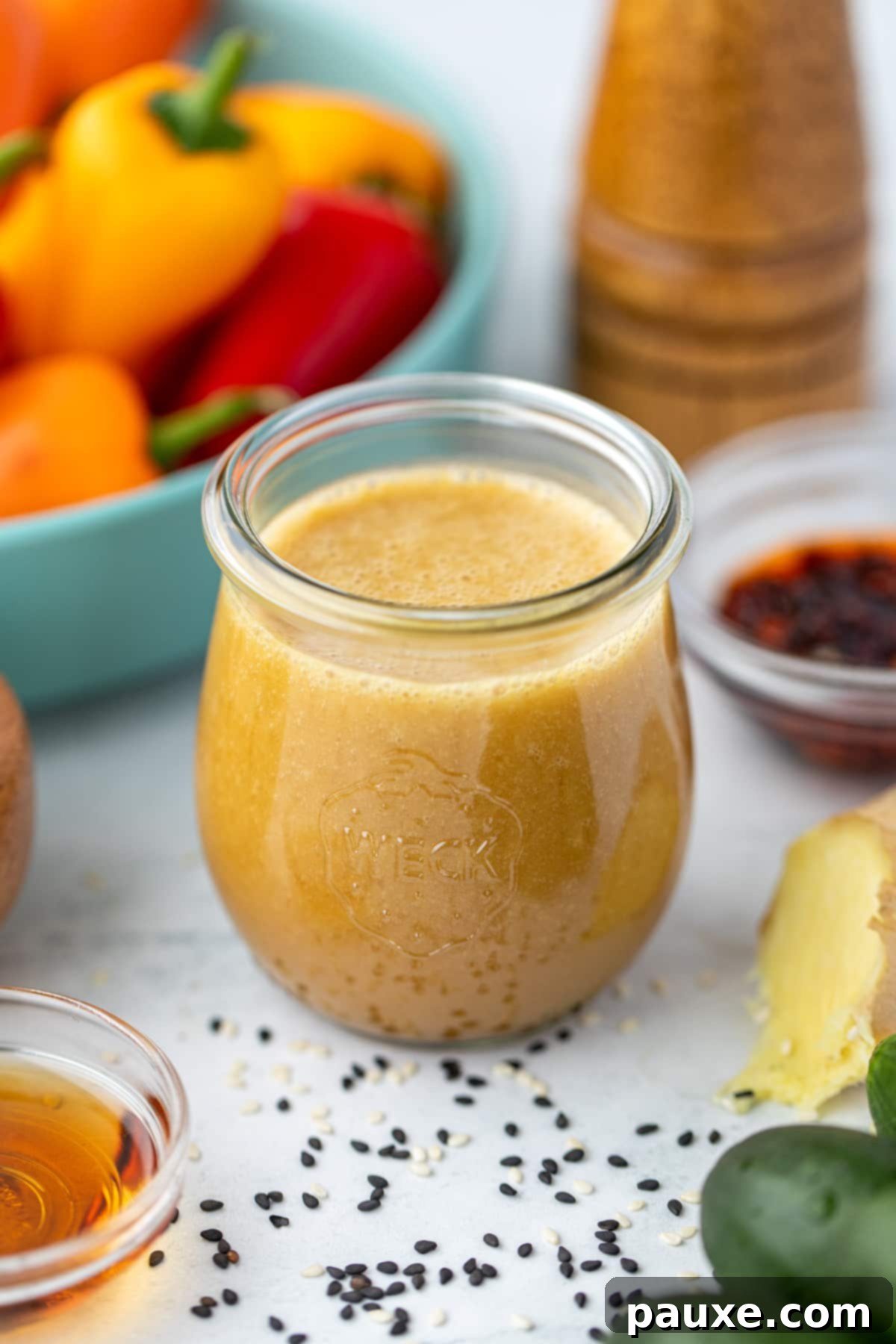
Experience a depth of flavor that a simple ranch dressing simply can’t offer. This ginger sesame vinaigrette is designed to invigorate your palate, making healthy eating both easy and incredibly enjoyable.
Why You’ll Love This Ginger Sesame Dressing
- Effortlessly Simple Ingredients: This recipe calls for just seven core ingredients, most of which you likely already have in your pantry or can easily find at any grocery store. No obscure items or specialty shops required, making it a convenient choice for any home cook.
- Unrivaled Versatility: While it shines as a salad dressing, its applications extend far beyond. Use it as a vibrant marinade for chicken, salmon, or tofu, a flavor-packed base for Asian-inspired slaws, a delicious sauce for stir-fries, or a finishing drizzle for roasted vegetables. It’s truly a multi-tasking star in the kitchen.
- Budget-Friendly: Making your own dressings at home is a smart way to save money compared to purchasing often overpriced bottled versions from the supermarket. You get more control over ingredients and a fresher product for a fraction of the cost.
- Healthier Homemade Option: By preparing your dressing from scratch, you avoid unwanted additives, preservatives, and excessive sugars or sodium often found in commercial dressings. You control the quality and quantity of every ingredient, leading to a healthier and more wholesome choice for your family.
- Customizable to Your Taste: This recipe provides a perfect base, but it’s incredibly forgiving and adaptable. Easily adjust the sweetness, spiciness, or tanginess to suit your personal preferences, allowing you to create a dressing that is uniquely yours.
- Impressive Flavor Profile: The harmonious blend of fresh ginger, toasted sesame oil, and garlic creates an irresistible aroma and taste that elevates any dish. It’s a gourmet flavor experience that’s deceptively easy to achieve.
Key Ingredients for Flavorful Sesame Ginger Dressing
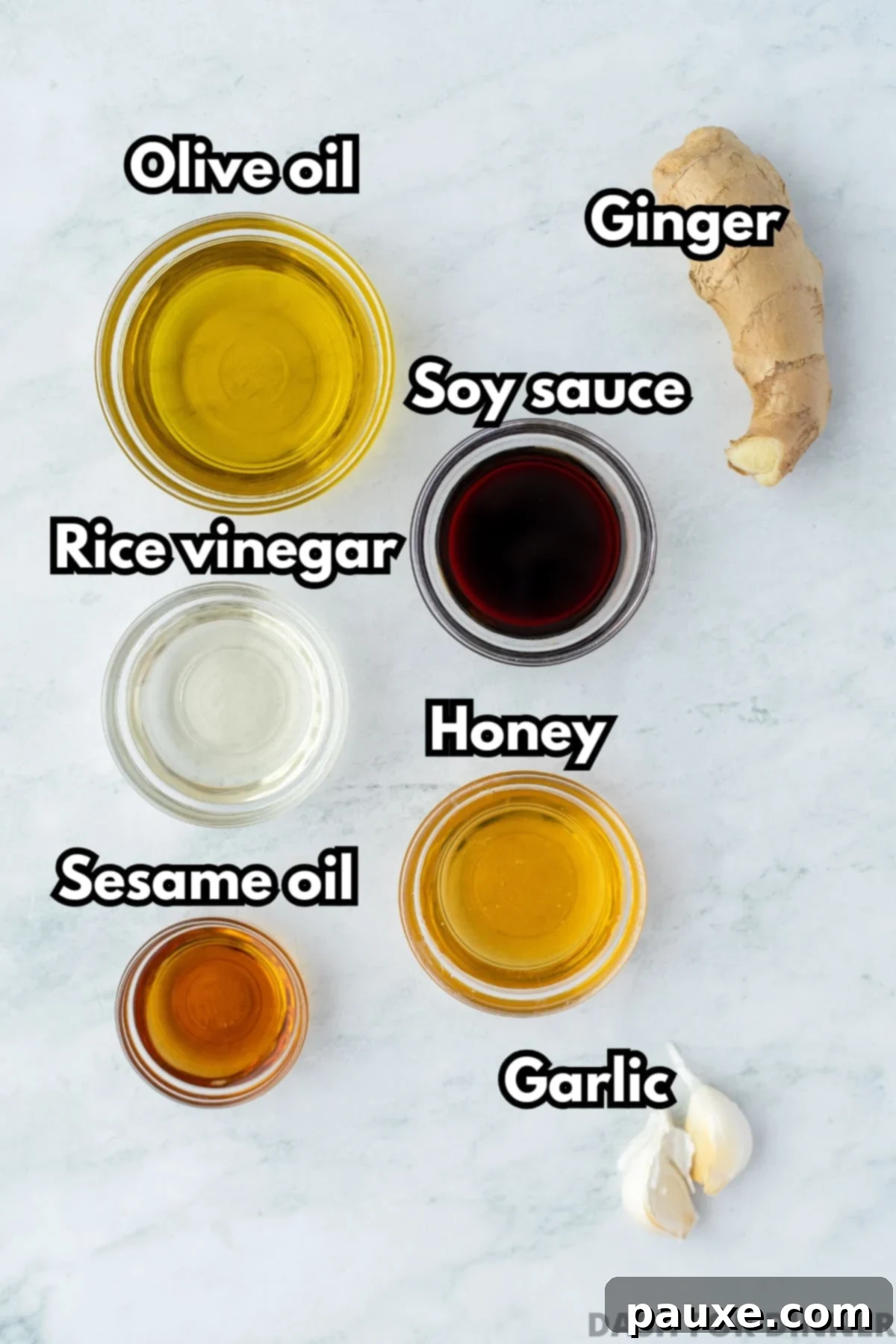
- Olive Oil: Forming the rich base of this vinaigrette-style dressing, extra-virgin olive oil provides a smooth texture and a touch of fruity undertone. For a lighter, more neutral flavor, feel free to substitute with avocado oil or another preferred neutral cooking oil. The quality of your oil can significantly impact the final taste.
- Rice Wine Vinegar: We highly recommend using “seasoned” rice vinegar, which offers a delightful balance of sweetness and tanginess. If you can’t find it, unseasoned rice vinegar will work, though you might want to add a touch more honey to balance the flavors. Mirin, a sweet Japanese cooking wine, is an excellent alternative that adds even more authentic Asian flair.
- Sesame Oil: This ingredient is crucial for that distinctive nutty, toasted sesame flavor that defines the dressing. Toasted sesame oil is generally preferred for its more intense aroma, but regular sesame oil will still yield delicious results. For an extra creamy texture and a different kind of nutty depth, tahini (ground sesame seed paste) makes a wonderful substitute, especially if you’re looking for a thicker consistency.
You’ll also need these fresh and aromatic elements:
- Fresh Garlic: The pungent, aromatic backbone of many Asian-inspired dishes. Using fresh garlic is non-negotiable for the best flavor.
- Fresh Ginger: Providing a warm, spicy, and slightly citrusy kick, fresh ginger is what gives this dressing its characteristic brightness. Don’t skimp on grating it finely for even distribution of flavor.
- Honey: This natural sweetener balances the savory and acidic notes, adding a lovely depth to the dressing. Pure maple syrup is an excellent vegan alternative.
- Soy Sauce: A cornerstone of umami, soy sauce provides saltiness and a rich savory profile. Opt for a good quality soy sauce or tamari for a gluten-free option.
- Ground Black Pepper: Just a pinch or two to add a subtle warmth and complete the flavor profile.
How to Craft Your Perfect Sesame Ginger Dressing
Creating this flavorful dressing is incredibly straightforward, involving just a few simple steps. The key to unlocking its full potential lies in the preparation of your fresh ingredients and a good mix.
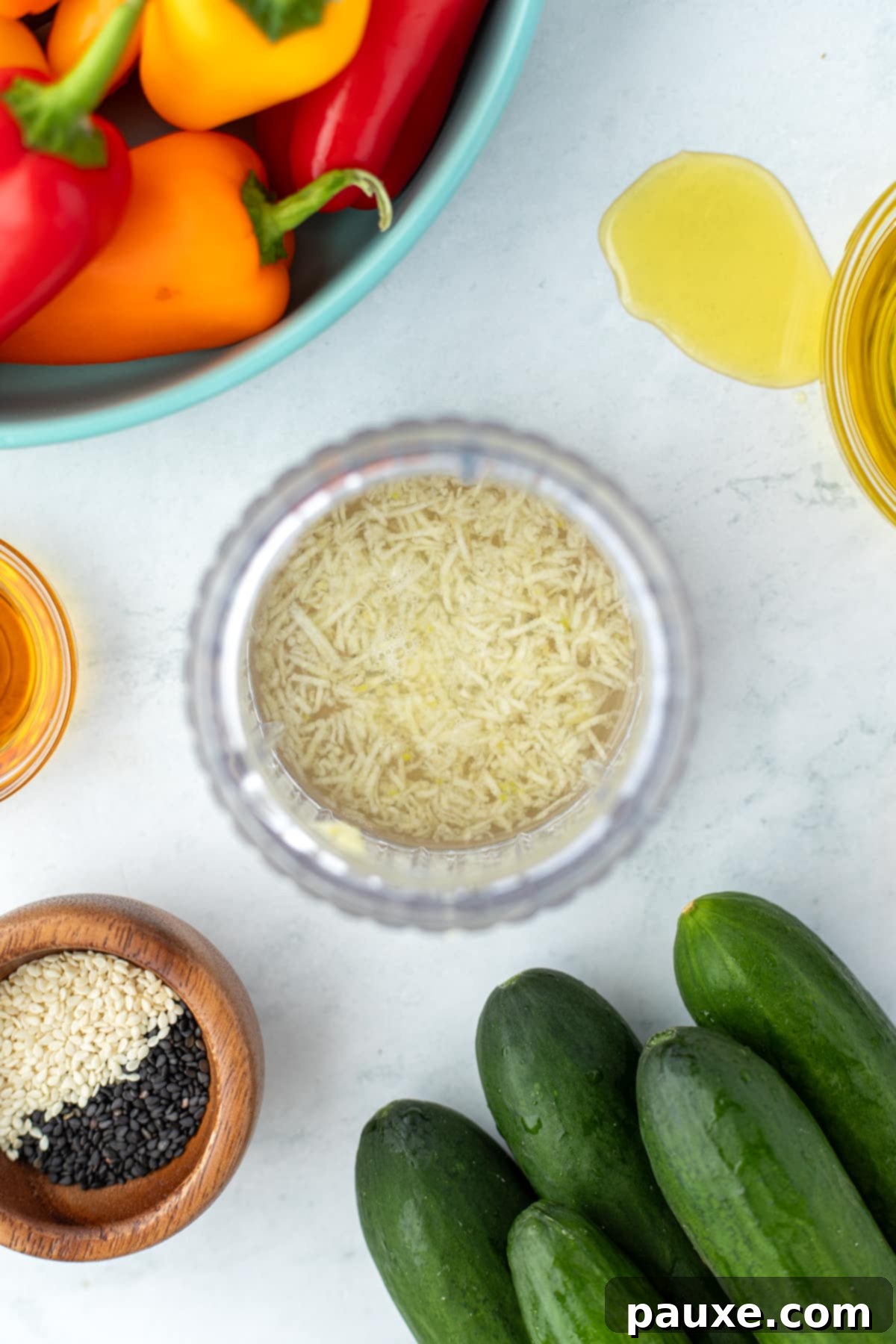
Mellow the Garlic: Begin by adding 2 tablespoons of rice wine vinegar to a small glass jar, mixing bowl, or mini blender. Finely grate 2 cloves of fresh garlic directly into the vinegar. Stir briefly to ensure the garlic is submerged, then allow it to sit undisturbed for about 5 minutes. This crucial step helps to soften the intense, sharp flavor of raw garlic, resulting in a more harmonious and less aggressive dressing.
Soaking raw garlic in an acid like vinegar for a short period is a culinary trick that tames its pungent bite, allowing its sweet, savory notes to shine without overwhelming the other flavors.
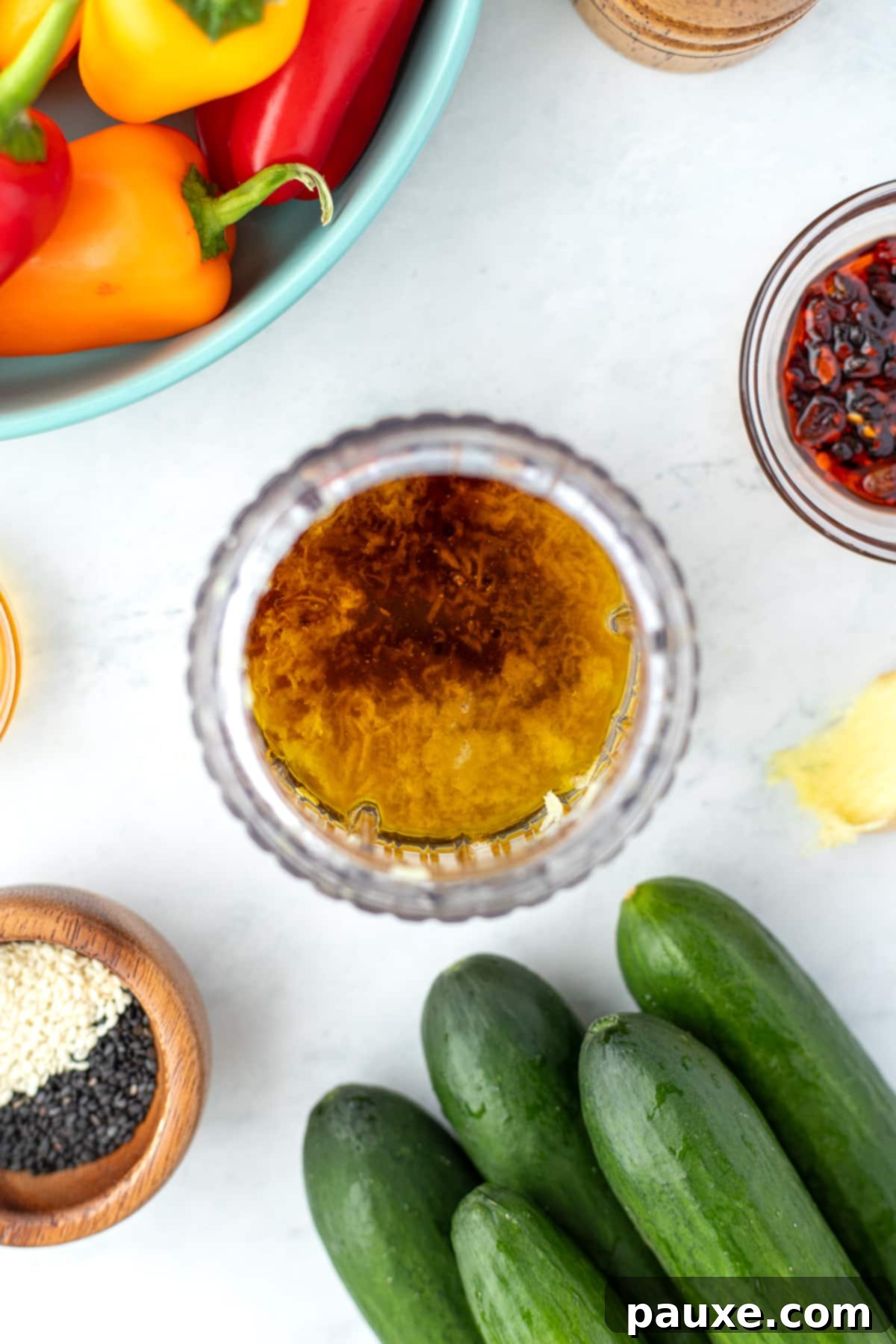
Combine Remaining Ingredients: Once the garlic has had a chance to mellow, add the rest of your ingredients to the same container. These include:
- ¼ cup olive oil
- 4-6 teaspoons honey (adjust to your preferred sweetness)
- 5 teaspoons soy sauce (or tamari for gluten-free)
- 1 tablespoon sesame oil (toasted is best for maximum flavor)
- 2 inches of fresh ginger, finely grated
- 2 pinches black pepper
Ensure all ingredients are added accurately to maintain the perfect flavor balance. Adjust honey or soy sauce later if you desire more sweetness or saltiness.

Blend or Whisk Until Combined: Now, it’s time to bring all those beautiful flavors together. For the smoothest consistency and best emulsification, we highly recommend using a mini blender or a milk frother. These tools create a uniform, creamy dressing that won’t separate quickly. If you don’t have these, vigorous whisking by hand will also work effectively. Continue mixing until all ingredients are thoroughly combined and the dressing appears homogenous.
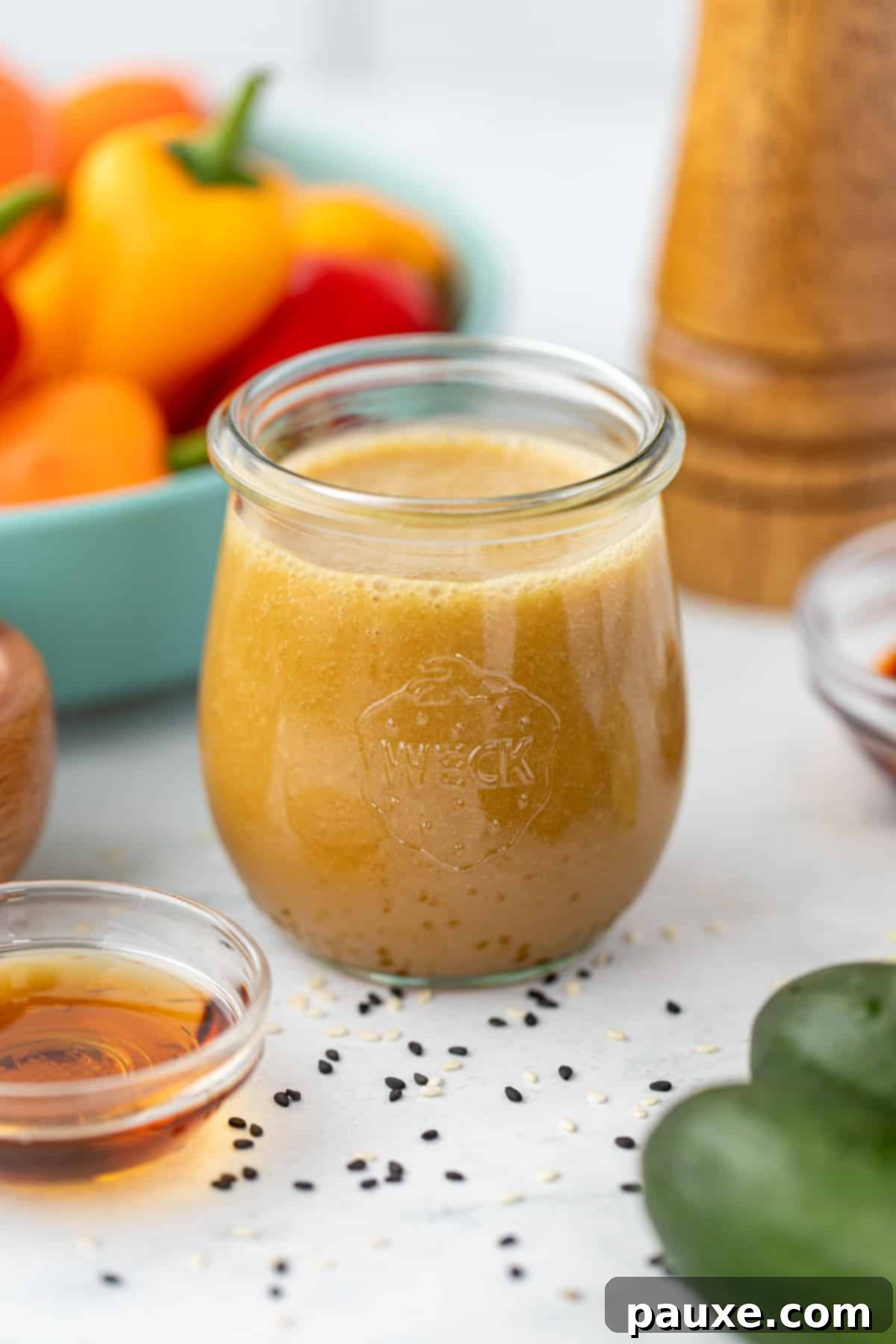
Serve Immediately or Chill: Your homemade ginger sesame dressing is now ready to use! For optimal flavor, especially if you have the time, cover the dressing with a lid and chill it in the refrigerator for at least 30 minutes before serving. This brief chilling period allows the flavors to meld and deepen, resulting in a more complex and satisfying taste experience. Give it a good shake before each use.
Customize Your Dressing with Exciting Flavor Variations!
- Brighten with Lime: For a zesty twist, try replacing the rice wine vinegar entirely with fresh lime juice. This adds a brighter, more acidic note that is particularly delightful when the dressing is served with crisp red bell peppers, sliced cucumbers, and red onion in a vibrant salad.
- Creamy Peanut Butter Infusion: Introduce a creamy, rich texture and a deeper nutty flavor by adding 2-3 tablespoons of smooth peanut butter to the dressing before blending. This transforms it into a fantastic peanut-ginger-sesame sauce, perfect for noodle bowls or as a dip. Blend well and taste, adjusting seasonings like honey or soy sauce as needed to achieve your desired balance.
- Spicy Kick: If you enjoy a bit of heat, consider adding a pinch of red pepper flakes or a small amount of sriracha to the mix. Start with a quarter teaspoon and add more to taste.
- Herbal Freshness: Fresh cilantro or chopped green onions can be stirred in just before serving for an added layer of freshness and aromatic complexity.
Unleash Its Versatility: Exciting Ways to Use Your Ginger Sesame Dressing
The beauty of this homemade ginger sesame dressing lies in its incredible versatility. Beyond a simple salad, it can elevate a wide array of dishes, making it a true kitchen staple. Here are some inspiring ideas to incorporate this flavor-packed vinaigrette into your meals:
- Classic Salad Dressing: Drizzle generously over mixed greens, shredded cabbage, or a vibrant medley of fresh vegetables for an invigorating and light meal.
- Dynamic Marinade: Its balanced flavors make it an exceptional marinade for various proteins. Use it to tenderize and flavor chicken breasts, succulent salmon fillets, juicy shrimp, or even firm tofu before grilling, baking, or pan-frying. Allow at least 30 minutes for marinating to infuse maximum flavor.
- Elevate Grain Bowls: Transform a simple grain bowl (quinoa, farro, brown rice) with roasted vegetables and protein into a gourmet experience by generously drizzling this dressing over the top. It binds all the elements together with its cohesive flavor.
- Noodle Salad Perfection: Toss with cold soba noodles, rice noodles, or even spaghetti, along with crisp vegetables like shredded carrots, cucumbers, and bell peppers, for a refreshing and satisfying noodle salad. Add cooked chicken or shrimp for a complete meal.
- Kale Salad Booster: Massage a small amount into kale leaves to tenderize them and infuse them with irresistible Asian-inspired flavors, perfect for a hearty and healthy salad base.
- Cucumber and Bell Pepper Salad: A match made in heaven! The crispness of cucumbers and bell peppers perfectly complements the bright, tangy notes of the dressing.
- Asian Slaw Essential: Take your coleslaw to the next level by using this as the dressing. It’s fantastic with shredded cabbage, carrots, and green onions.
- Dipper for Raw Vegetables: Serve it alongside a platter of raw veggies like carrot sticks, celery, bell pepper strips, and snap peas for a healthy and flavorful snack or appetizer.
- Crunchy Cabbage Salads: Ideal for any salad featuring crunchy cabbage, whether it’s a simple side dish or a more elaborate main course.
- Roasted Vegetable Enhancer: Drizzle over hot roasted vegetables such as Brussels sprouts, broccoli, asparagus, or carrots immediately after they come out of the oven for an added layer of savory and aromatic goodness. The heat brings out the best in the dressing’s flavors.
- Stir-Fry Sauce Base: Use it as a quick and easy sauce for your favorite stir-fry. Add a touch of cornstarch slurry for thickening if desired.
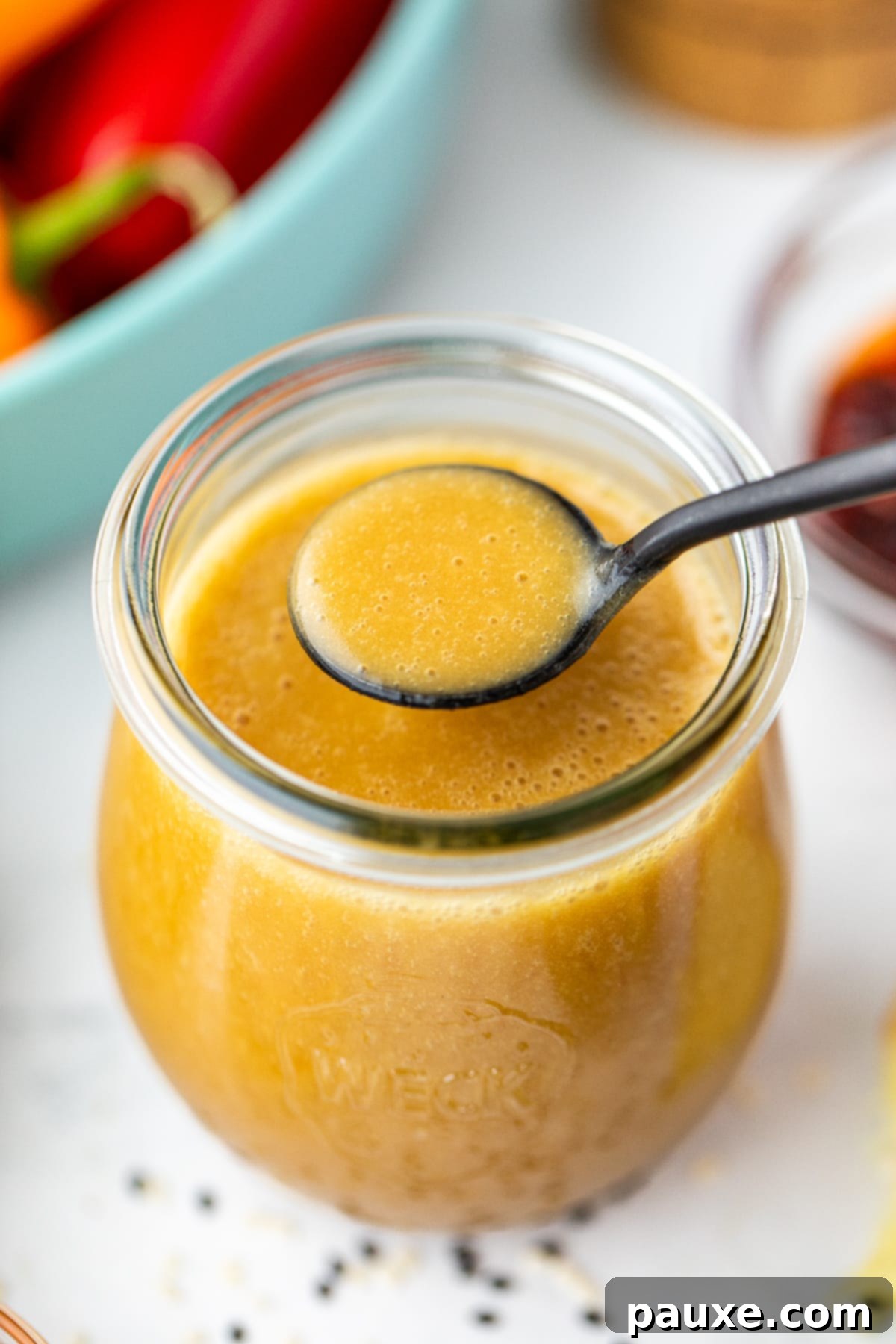
Smart Substitutions for Your Ginger Sesame Dressing
Don’t have an ingredient on hand, or looking for a slight variation? This recipe is incredibly adaptable. Here are some smart substitutions that won’t compromise on flavor:
-
Rice Vinegar Alternatives:
- Mirin: As mentioned, mirin is an excellent direct substitute, adding a similar sweet and tangy profile.
- Fresh Lime Juice: For a brighter, more citrusy dressing, fresh lime juice works wonderfully. It imparts a distinct zesty flavor that pairs well with the ginger.
- Mild Vinegars: White wine vinegar or apple cider vinegar can be used in a pinch, though they will offer a slightly different, less traditional flavor profile. Start with a smaller amount and taste before adding more, as their acidity can be more pronounced.
-
Toasted Sesame Oil Substitutes:
- Tahini: If toasted sesame oil is unavailable, tahini (ground sesame seed paste) is an excellent choice. It provides a rich, nutty sesame flavor and also contributes to a creamier, thicker dressing consistency. You might need to thin the dressing slightly with a touch of water if using tahini.
- Neutral Oil with a Dash of Sesame Seeds: In a true emergency, you can use a neutral oil (like avocado or canola) and add a few toasted sesame seeds for a hint of sesame flavor, though the depth won’t be the same as sesame oil.
-
Olive Oil Swaps:
- Avocado Oil: A fantastic neutral oil that is rich in monounsaturated fats and has a high smoke point, making it a healthy and versatile choice.
- Sunflower Oil: Another neutral-flavored oil that works well as a base.
- Canola Oil: A widely available and neutral option that blends seamlessly into the dressing.
- Grapeseed Oil: Light and neutral, it’s a great choice for vinaigrettes.
- Feel free to use any other neutral-flavored oil of your choice; the key is to allow the ginger and sesame to be the stars.
-
Soy Sauce Alternatives:
- Tamari: A gluten-free alternative to soy sauce that offers a very similar savory flavor.
- Coconut Aminos: For a soy-free and gluten-free option, coconut aminos provide a slightly sweeter, less salty umami flavor. You might need to adjust the amount for desired saltiness.
Make it Vegan: Vegan Sesame Ginger Dressing
This recipe is incredibly easy to adapt for a vegan diet. Simply swap out the honey for an equal amount of pure maple syrup. Maple syrup provides the same delightful sweetness and complements the other flavors beautifully, making this a perfect plant-based dressing option.

Expert Tips for the Best Ginger Sesame Dressing
Achieving the perfect homemade dressing is simple, but a few expert tips can elevate your results from good to absolutely outstanding. Pay attention to these details for a truly restaurant-quality vinaigrette:
- The Magic of Mellowing Garlic: This is arguably the most crucial step for a balanced dressing. Allowing the finely grated raw garlic to steep in the rice vinegar for just 5 minutes works wonders. It chemically reacts with the acid, significantly taming the pungent, sometimes overpowering, raw garlic flavor. The result is a garlic flavor that is present and aromatic, but smooth and integrated rather than harsh. Don’t skip this quick but impactful step!
- Freeze Your Ginger Root for Freshness and Ease: Fresh ginger is indispensable for this recipe, but whole roots can spoil quickly. A fantastic solution is to wrap your leftover ginger root tightly in plastic wrap and store it in the freezer. When you need it, you can grate it directly from frozen using a fine grater. It grates beautifully and tastes just as vibrant and fresh as unfrozen ginger, ensuring you always have some on hand without waste.
- Grating for Uniform Flavor: For both the fresh garlic and ginger, we highly recommend using a fine grater (like a microplane). This creates tiny, almost paste-like pieces that seamlessly incorporate into the dressing. This method prevents any large, unwelcome chunks of garlic or ginger from floating in your dressing and, more importantly, ensures that their potent flavors are evenly distributed throughout, creating a consistent and delightful taste experience in every spoonful.
- Taste and Adjust: Always taste your dressing before serving! This is where you fine-tune the flavors to your preference. Need more sweetness? Add a touch more honey. Prefer it tangier? A little extra rice vinegar will do the trick. A pinch more salt from soy sauce can brighten everything up.
- Shake Before Each Use: Vinaigrettes naturally separate over time, especially when stored in the refrigerator. Before each use, give your jar a vigorous shake to re-emulsify the dressing and ensure every serving is perfectly blended.
- Room Temperature Ingredients (Optional but Recommended): While not strictly necessary for this recipe, using ingredients that are at room temperature (especially the olive oil and honey) can help them emulsify more easily and create a smoother dressing.
More Delicious Salad Dressing Recipes to Try
- Greek Yogurt Ranch (Dip and Dressing)
- Leon Salad Dressing
- Greek Vinaigrette
- Sun Dried Tomato Vinaigrette
If you loved this recipe for Ginger Sesame Dressing, please share your thoughts! Leave a 5-star review in the recipe card below or drop a comment to let us know. You can also tag me on Instagram @dashfordinner to show off your delicious creations!
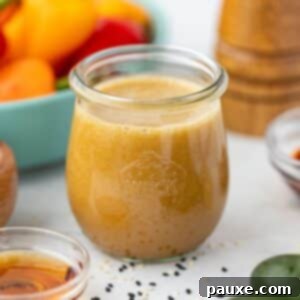
Ginger Sesame Dressing
This ginger sesame dressing is made with simple ingredients and is perfect for salads, grain bowls, or even as a flavorful marinade!
Rating: 5 out of 5 stars (based on 1 vote)
Print Recipe
Pin Recipe
Course: Condiments
Cuisine: American, Asian
Prep Time: 10 minutes
Total Time: 10 minutes
Servings: 10 servings
Calories: 74 kcal per serving
Author: Dorothy Bigelow
Ingredients
- 2 tablespoons rice wine vinegar (seasoned or mirin)
- 2 cloves garlic, finely grated
- ¼ cup extra-virgin olive oil
- 4-6 teaspoons honey (or maple syrup for vegan)
- 5 teaspoons soy sauce (or tamari for gluten-free)
- 1 tablespoon sesame oil (toasted is recommended, or tahini)
- 2 inches of fresh ginger, finely grated
- 2 pinches ground black pepper
Instructions
Mellow the garlic. First, add the rice vinegar to a small blender, bowl, or glass jar. Then, grate the garlic into the container, swishing it around so the garlic is submerged under the rice vinegar. Allow to rest for about 5 minutes; this crucial step will tame the sharpness commonly associated with raw garlic.

Add the remaining ingredients. Pour in the olive oil, honey, soy sauce, sesame oil, fresh grated ginger, and black pepper.

Blend or mix well. Pulse the dressing in a mini blender, mix with a handheld frother, or whisk vigorously by hand until all ingredients are thoroughly combined and the dressing is emulsified.

Shake before serving. If you’re preparing your dressing in advance, transfer it to a small glass jar with a lid. Store in the refrigerator until you’re ready to use. The dressing will naturally separate over time, so give it a good shake before serving to re-emulsify.

Did you try this recipe?
Tag me at @dashfordinner and share your photos!
Notes
- Storage: Keep dressing in an airtight container in the refrigerator for 1-2 weeks. Always shake well before serving to combine ingredients.
- With lime: Substitute the rice wine vinegar for fresh lime juice for a brighter, more zesty flavor.
- With peanut butter: For a creamy and rich variation, mix in 2-3 tablespoons of smooth peanut butter before blending. Taste and adjust flavors as needed for sweetness and saltiness.
Nutrition
Calories: 74 kcal | Carbohydrates: 3g | Protein: 0.4g | Fat: 7g | Saturated Fat: 1g | Polyunsaturated Fat: 1g | Monounsaturated Fat: 5g | Sodium: 168mg | Potassium: 19mg | Fiber: 0.1g | Sugar: 2g | Vitamin A: 1 IU | Vitamin C: 0.3mg | Calcium: 3mg | Iron: 0.2mg
Please note that some of my blog posts here at Dash for Dinner may contain affiliate links. If you make a purchase through these links, I will get a small commission at no additional cost to you. Please see my Disclaimer for more information.

